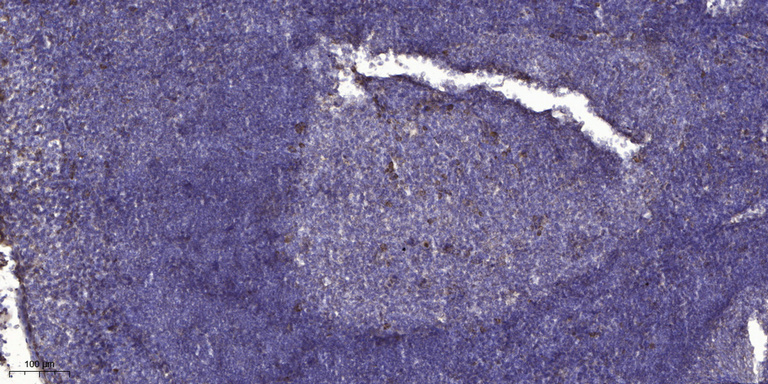- Home
- About
- Promotions
-
Products
-
Elisa Kits
- |
-
Primary antibodies
- |
-
Secondary antibodies
- |
-
Proteins
- |
-
IHC reagents
- |
-
WB reagents
- PonceauS Staining Solution
- PBST Washing Buffer, 10X
- 1.5M Tris-HCl Buffer, pH8.8
- 1M Tris-HCl Buffer, pH6.8
- 10% SDS Solution
- Prestained Protein Marker
- TBST Washing Buffer, 10X
- SDS PAGE Loading Buffer, 5X
- Stripping Buffered Solution
- Tris Buffer, pH7.4, 10X
- Total Protein Extraction Kit
- Running Buffer, 10X
- Transfer Buffer, 10X
- 30% Acr-Bis(29:1) Solution
- Tris电泳液速溶颗粒
- PBS(1X, premixed powder)
- TBS(1X, premixed powder)
- 快速封闭液
- 转膜液速溶颗粒
- Chemical reagents
- News
- Distributor
- Resources
- Contact
- Home
- >
- Info
- >
- FBN3 rabbit pAb
- >
- Go Back
FBN3 rabbit pAb
- Catalog No.:YT6743
- Applications:IHC;IF
- Reactivity:Human
- Immunogen:
- Synthesized peptide derived from human FBN3 AA range: 1311-1361
- Specificity:
- This antibody detects endogenous levels of FBN3 at Human
- Formulation:
- Liquid in PBS containing 50% glycerol, 0.5% BSA and 0.02% sodium azide.
- Source:
- Polyclonal, Rabbit,IgG
- Dilution:
- IHC 1:50-200. IF 1:50-200
- Purification:
- The antibody was affinity-purified from rabbit antiserum by affinity-chromatography using epitope-specific immunogen.
- Storage Stability:
- -15°C to -25°C/1 year(Do not lower than -25°C)
- Molecular Weight(Da):
- 309kD
- Background:
- This gene encodes a memebr of the fibrillin protein family. Fibrillins are extracellular matrix molecules that assemble into microfibrils in many connective tissues. This gene is most highly expressed in fetal tissues and its protein product is localized to extracellular microfibrils of developing skeletal elements, skin, lung, kidney, and skeletal muscle. This gene is potentially involved in Weill-Marchesani syndrome. [provided by RefSeq, Mar 2016],
- Function:
- function:Fibrillins are structural components of 10-12 nm extracellular calcium-binding microfibrils, which occur either in association with elastin or in elastin-free bundles. Fibrillin-containing microfibrils provide long-term force bearing structural support.,PTM:Probably forms intermolecular disulfide bonds either with other FBN3 molecules or with other components of the microfibrils.,similarity:Belongs to the fibrillin family.,similarity:Contains 44 EGF-like domains.,similarity:Contains 9 TB (TGF-beta binding) domains.,tissue specificity:Predominantly expressed in connective tissues such as skeletal muscle, tendon, skin, perichondrium and periosteum. Highly expressed in fetal lung, brain, kidney. Expressed at low level in prostate, testis, mammary gland, uterus, ovary, placenta, bladder, adrenal gland, thyroid, fetal thymus, fetal liver, liver, fetal heart and heart.,
- Subcellular Location:
- Secreted, extracellular space, extracellular matrix .
- Expression:
- Predominantly expressed in connective tissues such as skeletal muscle, tendon, skin, perichondrium and periosteum. Highly expressed in fetal lung, brain, kidney. Expressed at low level in prostate, testis, mammary gland, uterus, ovary, placenta, bladder, adrenal gland, thyroid, fetal thymus, fetal liver, liver, fetal heart and heart.

- Immunohistochemical analysis of paraffin-embedded human tonsil. 1, Antibody was diluted at 1:200(4° overnight). 2, Tris-EDTA,pH9.0 was used for antigen retrieval. 3,Secondary antibody was diluted at 1:200(room temperature, 30min).




